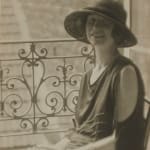

Man Ray
Edna St. Vincent Millay, 1923 'circa'
Annotated 'Edna St. Vincent Millay' (on the mount, lower right); stamped with the photographer's credits 'PHOTO MAN RAY PARIS' and 'MAN RAY 31 bis, Rue Campagne Première Paris XIVᵉ' and annotated 'Millay' (on the verso)
Vintage silver print mounted on paper
11.4 by 8.9 cm (4½ by 3½ in.)
Mount: 17.8 by 12.7 cm (7 by 5 in.)
Mount: 17.8 by 12.7 cm (7 by 5 in.)
69107
© Man Ray 2015 Trust / Artists Rights Society (ARS), NY / ADAGP, Paris 2023
Edna St. Vincent Millay (American, 1892 - 1950) was a playwright and poet who received a Pulitzer Prize for Poetry in 1923 for The Ballad of the Harp-Weaver, becoming the...
Edna St. Vincent Millay (American, 1892 - 1950) was a playwright and poet who received a Pulitzer Prize for Poetry in 1923 for The Ballad of the Harp-Weaver, becoming the third woman to achieve this honor. She moved from New York to Paris in 1921, hoping to develop a more accepting and discerning audience for her work, which drew from her bohemian experiences as a bisexual writer in New York’s Greenwich Village. Man Ray photographed Millay in the early 1920s, before she married Dutch coffee importer Eugen Jan Boissevain and moved back to upstate New York, where she would live and write for the rest of her life.

